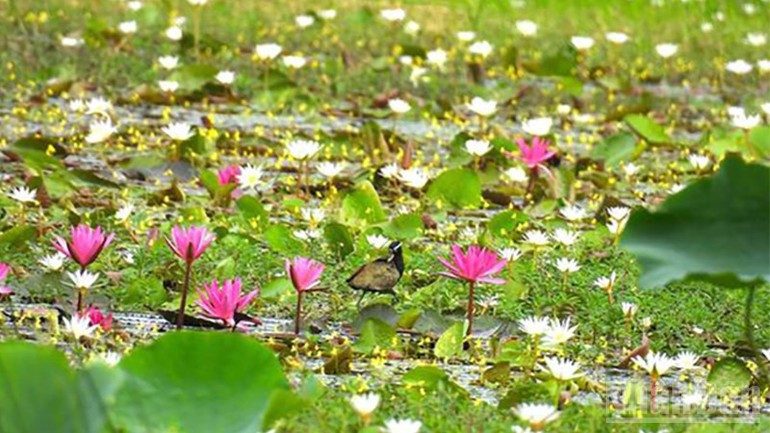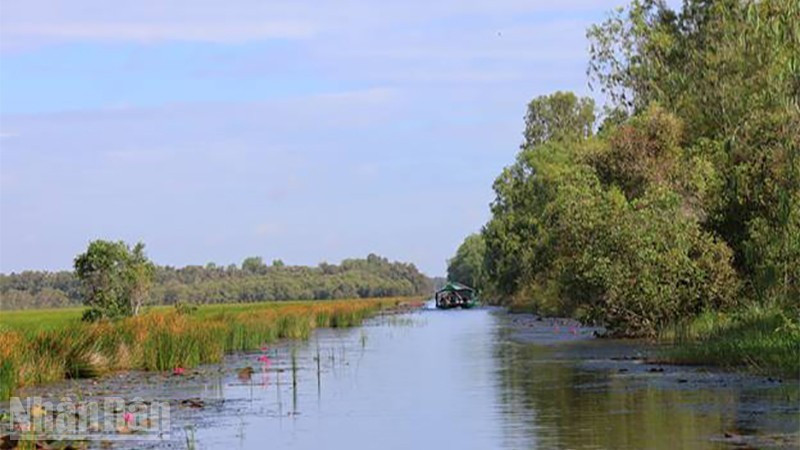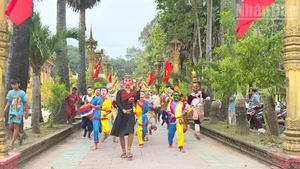Grass and melaleuca revival
Visiting the Go Lau Voi area in sub-zone A1 of Tram Chim National Park, home to the natural nang kim (Eleocharis atropurpurea) grass fields (the red-crowned crane’s favourite food), was a familiar “rendezvous” of the cranes many years ago.
Before our eyes stretched a lush green field of nang kim grass during the flood season. According to Tram Chim National Park, this thriving grassland is the result of persistent efforts to restore the ecosystem, providing natural food sources for the red-crowned crane to return.
Sharing about the ecosystem restoration achievements at Tram Chim over the past two years, Doan Van Nhanh, Deputy Director of Tram Chim National Park Conservation Centre, said: “In more than two years, with multiple coordinated solutions, we have restored nearly 100 hectares of nang kim grassland in the park’s core zone.
The success lies not only in the numbers of hectares restored, but also in the quality of the grassland and the strong tuber formation. This is an important premise to proactively ensure the natural food source preferred by the red-crowned crane.”
To achieve this, the Tram Chim National Park applied various scientific methods. First, controlled burning was conducted to remove thick undergrowth. Then, ploughing was carried out to create favourable conditions for nang kim growth, alongside soil pH control.
However, the most crucial factor was water level regulation by season (in previous years, the ecosystem had been harmed by inappropriate water management). Human intervention based on scientific evidence has enabled nature here to “self-heal”.
The changes in the Tram Chim National Park’s endemic vegetation indicate that water management here is now on the right track, enabling native plants to recover and grow naturally.
Dr. Tran Triet
Alongside nang kim grass, the melaleuca forest ecosystem is also reviving strongly. Returning to sub-zone A1, where a fire occurred in June 2024, young melaleuca trees are rising robustly beside charred trunks, some already reaching nearly two metres high.
Dr. Tran Triet, Director of the Southeast Asia Programme of the International Crane Foundation, explained that for melaleuca forests to grow sustainably, water must be seasonally regulated – with dry and flood periods – so that the roots can develop. The changes in the Tram Chim National Park’s endemic vegetation indicate that water management here is now on the right track, enabling native plants to recover and grow naturally.
Implementing the project on conserving and developing red-crowned cranes at Tram Chim, Dong Thap Province has identified the task not merely as protecting the cranes, but also preserving the primeval ecosystem of the ancient Dong Thap Muoi.
Spreading the green values
Ecosystem recovery has delivered impressive results. Increasing numbers of waterbirds are returning to Tram Chim. Many rare birds, which previously did not breed here, have come back.
Species such as recurvirostridae, comb ducks, nettapus coromandelianus, painted storks, and various migratory birds now choose Tram Chim as a stopover and breeding ground. Notably, in 2024, Tram Chim welcomed the return of seven red-crowned cranes – an encouraging signal for the conservation and development project.
Nature’s revival is not confined to land. Aquatic ecosystems have also improved visibly. The park’s canals are now clear, reflecting the underwater vegetation.
Characteristic aquatic plants of the ancient Dong Thap Muoi, such as purple bladderwort, yellow bladderwort, and white water lilies, have reappeared in greater abundance.
Dr. Tran Triet noted: “It has been a long time since we have seen so many white water lilies blooming along Tram Chim’s canals. This is an acid-loving species, indicating clear improvement in water quality, similar to the conditions of the old Dong Thap Muoi.”

Ecosystem restoration has brought not only scientific value, but also immense cultural and spiritual significance. Tram Chim National Park is moving towards an integrated ecological model that combines nature conservation, eco-tourism development, and environmental education.
The Red-crowned Crane Conservation and Development Project is not only a story of saving a rare species, but also a testament to Dong Thap Province’s strong commitment to proactively investing budget resources and mobilising social contributions to preserve biodiversity.
Alongside provincial efforts has been the community’s consensus, with every citizen, business, and social organisation demonstrating responsibility in protecting the “green lung” of their homeland.
Bui Minh Nguyet, representative of WildTour Company in Ho Chi Minh City, shared: “We have closely cooperated with the Tram Chim National Park in developing tourism tours linked with red-crowned crane conservation. Besides observing characteristic flora and fauna, we have designed experiential products, such as ‘A Day as a Farmer’, helping visitors, especially students, understand the importance of crane conservation and why agriculture around Tram Chim must follow green and sustainable practices.”
These models both create new tourism products and plant seeds of environmental awareness in the younger generation. Such activities have received strong attention and positive response from the community.
More and more buses bring students to the Tram Chim National Park, where they both play and learn while listening to the story of a land that “lives in harmony with nature” to revive itself. This is a positive signal, showing that the community is not standing aside, but is joining Dong Thap Province in spreading green values.
















